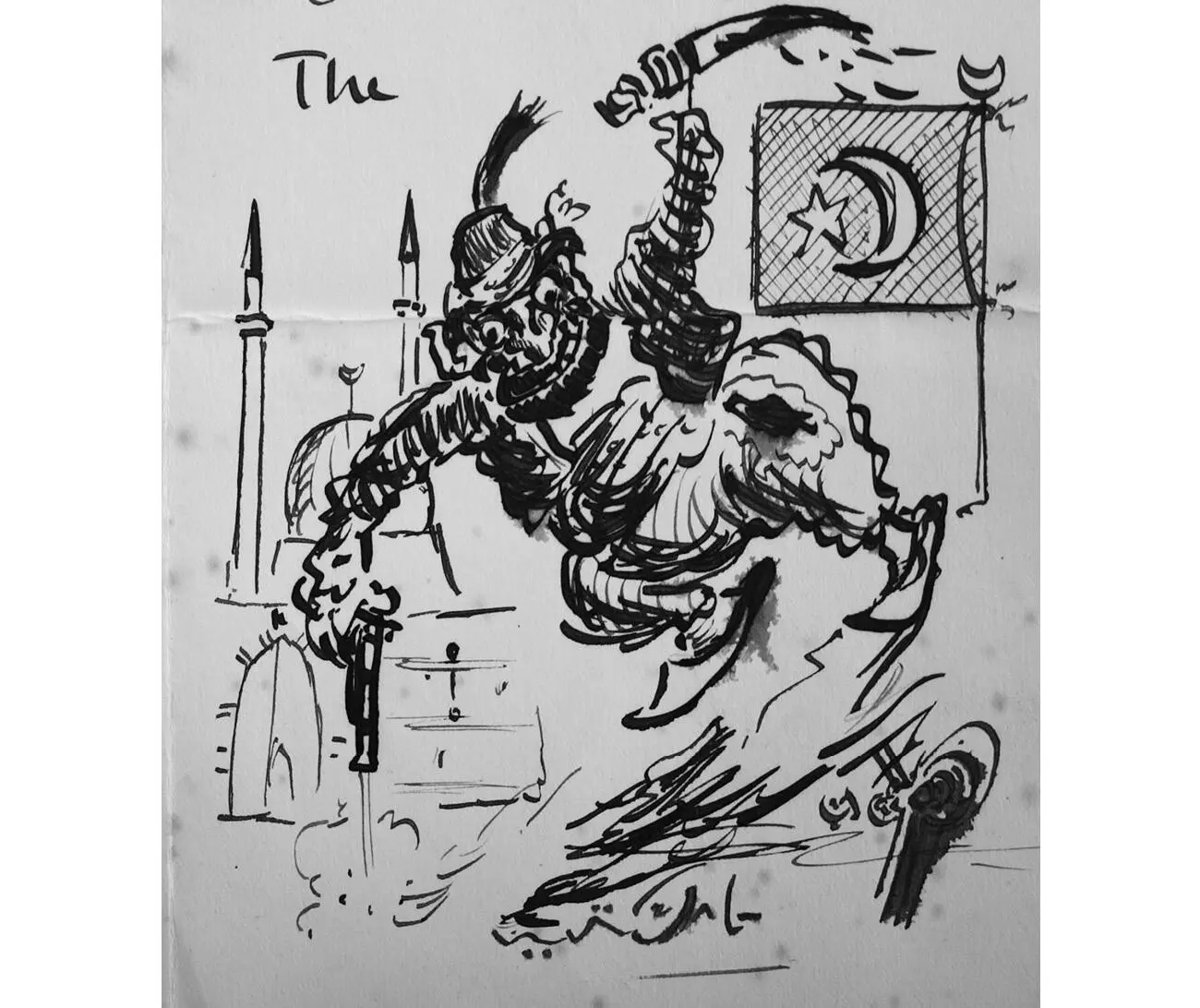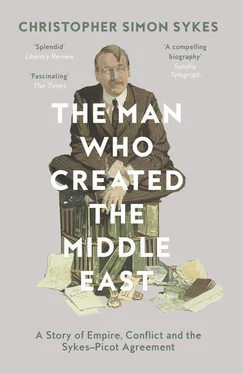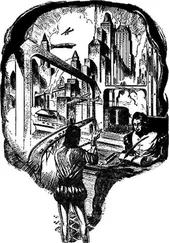As Mark and his party drew closer to Bitlis, a strategic Armenian town that was to see 15,000 of its inhabitants massacred by the Turks in July 1916, they began to see more and more snow, which soon became so deep that they had to drag their mounts through it. His plan had been to head straight from here to the Black Sea port of Trebizond, and then home, but when this proved impossible he was forced to go to Van instead. This meant abandoning the muleteers in favour of fifteen man-sledges, each of which could carry a hundred pounds weight of baggage. One of them even had the added weight of Isá, who, fearful of getting cold, had drunk a whole bottle of mastic, the local aniseed-flavoured spirit, and had become so drunk that he had to be tied face-down onto his sledge. Mark was astonished at the strength of the men who pulled these sledges. ‘They kept up a pace of about three and a half miles an hour,’ he noted. ‘They mounted steepish hills with only raw hide lashed under the soles of their feet, and they only rested for five minutes or so every three quarters of an hour. The heavy breathing of the sledge-draggers, the gentle zipping of the sledges as they passed over the snow, the occasional moaning of the drunken man, and the stamping of the cold feet had such an effect on me that a couple of hours after leaving Bitlis I was fast asleep. When I awoke I saw a glorious sunrise; the red flush of the sun on the waters of Lake Van … was beautiful indeed.’ 30
Crossing Lake Van, the largest lake in Turkey and seventy-four miles across at its widest point, was a hazardous affair. They hired a fifty-ton fishing boat, the Jámi , hired from and captained by its Armenian owner, and though at first all went well, after two hours the wind dropped, and there followed a fearful nocturnal storm during which the sail split, water began to seep in, and the boat began to list alarmingly. The crew, including the skipper, panicked and proved useless, and when Mark tried to get Isá to help him get the ballast straight, he became ‘quite childish, and … screamed “Why you bring me to this debil country? I say bad word for the day I came with you; rubbish boat, rubbish captain, rubbish sea; I say bad word for the religion of this lake!” Then as the boat took a particularly heavy roll, he stood on his feet with a cry of “Our God help us!” (the us being prolonged into a perfect scream) and then collapsed on the side of the boat and lay there vomiting and praying.’ 31In the end Mark was reduced to watching over the ballast and bailing by himself. It was, he confessed, ‘one of the most dismal vigils I have ever kept’, 32and Mikhãil, his cook, later confessed, ‘We were as near death as a beggar to poverty.’ 33
The storm had abated by sunrise, and the shore was in sight. Their plight had been noted from the shore by a Kurdish horseman, who galloped along the cliffs and, with the aid of a stout whip, persuaded a group of Armenians to tow the Jámi to safety. In Van, Mark spent a week with the British consul, Captain Maunsell, before setting out on the slow and arduous trek to the Russian border. The last part of this journey, over a high mountain pass, was almost too much for Isá, the rarefied air giving him heart palpitations. He ‘threw himself on the ground gasping,’ wrote Mark, ‘unable to walk any farther. I tried to carry him on my back but the result was that we both rolled head over heels in the snow; so I got out the medicine chest and gave him a mixture of ginger, brandy and opium …’ 34Eight days after finally reaching the Russian border, Mark reached Akstapha, where he boarded the Trans-Caucassian railway bound for Tiflis and Batoum, port of call for the steamer to Constantinople. ‘Isá, Jacob and Michael came to the station and bade me a tearful farewell; and I feel sure that the sorrow they expressed was sincere … we had seen much together and a mutual feeling of respect had grown. Certainly I must confess to a lump in my throat when Isá quavered through the window of the parting train “ Masalaam . I pray our God He help you always.” I can only add Inshallah .’ 35
During the time that he had been travelling, Edith may well have been on Mark’s mind, but, he later told her, he ‘neither wrote nor spoke of you to any man’. 36On his return, he began to write to her, his first letters, posted in May 1899, being quite formal, addressing her as ‘Dear Miss Gorst’ and signing off ‘Yours sincerely, Mark Sykes’. By August, she was still ‘Miss Gorst’, while he had given himself a nickname, ‘The Terrible Turk’, that was accompanied by a drawing, and was an allusion to a phrase originally used by Gladstone when condemning the slaughter by the Turks of thousands of Bulgarians in 1876.

A month later, he was beginning his letters with the words ‘Honourable and Well-Beloved Co-Religionist’ shortly to be abbreviated to ‘H. and W.B. Co-Relig’. As soon as he returned to Cambridge he invited her to dinner. ‘You may remember,’ he said, ‘how … little I spoke at dinner, and then only did I know that I had a real affection for you’, adding, ‘I tell you, if … you had a hump in the middle of your back, a beard like a Jew, eyes that squinted both ways, were bald as a highroad, and had only three black teeth in a mouth like a cauldron, still my affection for you would be the same.’ 37
However much his thoughts may have been on Edith, he was also fired by a desire to return to the East. ‘I am preparing already for my next journey,’ he wrote to Henry Cholmondeley in August. ‘Entering Turkey by Russia on the Van Side, my rough scheme so far is to buy a complete Equipment gradually & send it to Erivan in small quantities, and then to arrange with Maunsell to send me mules to the frontier, & a certain dragoman I know of there. Then to use those mules & my own equipment for about 5 months, thoroughly visiting Koordistan [ sic ], presently working down to Baghdad where another dragoman & fresh mules would await, from Baghdad I should work across to Jebel Hauran and thence southward.’ 38
Such a journey, which was to take up the better part of a year, was expensive, in spite of his attempt to save money by buying his mules outright rather than renting them by the day. He calculated the expenses as follows: ‘Jacob, his servant, £40; Dragoman, £50; Cook, £30; Soldiers, £60; Fodder, £60; Mules, £54; Outfit, including carriage, £200; Muleteers, £30; Cash, £200; and Journey to Turkey and back to London, £35.’ By his very poor mathematics, he reckoned this as adding up to £819, the actual sum being £759, or approximately £82,000 at today’s values. ‘I include, as you see,’ he explained to Cholmondeley, ‘£200 cash for accidents etc, but I count on selling my mules and equipment for at least £150 at the end.’ His intention was to leave England on 15 June 1900, towards the end of the summer term, and end up in Cairo on 10 May 1901, and, with this trip in mind, he intended to devote his next year at Cambridge to the study of the Middle East and its political aspects. ‘I think if I am able to do as I propose,’ he told Cholmondeley, ‘I shall be as well informed on Eastern subjects as many M.P.s who pose as Orientalists.’ 39
In spite of Professor Browne’s reservations about Mark’s capacity for ‘not learning’, he found him a delightful companion, and he was the perfect choice to tutor him in the history and politics of the Middle East. Though Browne had paid only one visit there, to Persia between 1887 and 1888, he had made good use of his time, travelling through the whole country, and mixing with the company of Persians, mystics and Sufi dervishes. It was a trip that eventually resulted in the publication of his book A year amongst the Persians , as well as numerous articles on subjects such as the rise of the Babi movement. Together he and Mark spent many a happy hour exchanging anecdotes about their travels, while he also did his best to instil a little history into his pupil, as well as attempting to increase his Arabic vocabulary. Their political views, however, were poles apart, with the Professor adopting a Nationalist view, while those of the undergraduate Mark veered towards the Imperialist.
Читать дальше












